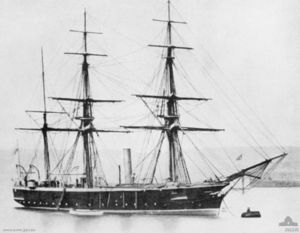
Summary
The Osprey class was a Royal Navy class of screw-driven sloops built between 1874 and 1877. Nine additional ships were built to a revised design, the Doterel-class sloop. They were the first class of ship in the Royal Navy to use glass scuttles.
 Penguin
| |
| Class overview | |
|---|---|
| Name | Osprey-class sloop |
| Operators | |
| Cost | Between £49,217 (Cormorant) and £56,221 (Pelican) |
| Built | 1874–1877 |
| In commission | 1874–1949 |
| Completed | 5 |
| Scrapped | 5 |
| General characteristics [1] | |
| Type | Screw composite sloop |
| Displacement | 1,130 long tons (1,150 t) |
| Length | 170 ft (51.8 m) (p/p) |
| Beam | 36 ft (11.0 m) |
| Draught | 15 ft 9 in (4.8 m) |
| Depth | 19 ft 6 in (5.9 m) |
| Installed power | 666–1,056 ihp (497–787 kW) |
| Propulsion |
|
| Sail plan | Barque rig |
| Speed | 9–12 knots (17–22 km/h; 10–14 mph) |
| Range | 1,480 nmi (2,740 km; 1,700 mi) at 10 knots (19 km/h; 12 mph) |
| Complement | 140 |
| Armament |
|
Design edit
They were of composite construction, with wooden hulls over an iron frame. Five ships of the class were built, which had been designed in 1874 by the Royal Navy's Chief Constructor, William Henry White.[1] They were the first ships in the Royal Navy to have glass scuttles instead of solid plug scuttles.[1]
Propulsion edit
The original design, as fitted to the first two ships of the class, was a single-expansion returning-rod steam engine, but the power was insufficient, and they failed to meet the contracted speed. Wild Swan and Penguin were re-engined after their first commission to match the better engines in the rest of the class.[1] In the final installation, power was provided by three cylindrical boilers, which supplied steam at 60 pounds per square inch (410 kPa) to a two-cylinder horizontal compound-expansion steam engine driving a single 13-foot-1-inch (3.99 m) screw. The power varied wildly from ship to ship, with Penguin generating only 666 indicated horsepower (497 kW) and Pelican managing nearly twice as much, at 1,056 indicated horsepower (787 kW). Because of this, top speeds ranged between 10 and 12 knots.[1][Note 1]
Armament edit
They were armed with two 7-inch (90cwt) muzzle-loading rifled guns on pivoting mounts, and four 64-pounder muzzle-loading rifled guns (two on pivoting mounts, and two broadside). Four machine guns and one light gun completed the weaponry. Wild Swan and Pelican later had the muzzle-loading guns replaced with two 6-inch (81cwt) breech-loaders and six 5-inch (31cwt) breech-loaders.[1]
Sail plan edit
All the ships of the class were provided with a barque rig,[1] that is, square-rigged foremast and mainmast, and fore-and-aft sails only on the mizzen mast.
Crew edit
They had a complement of approximately 140 men.[1]
Development edit
The design was revised in 1877 and nine ships were ordered to a modified version, the Doterel-class sloop. Identical in many respects, the Doterels lacked the graceful clipper bow of the Ospreys, although they benefited from more power.[1]
Ships edit
| Name | Ship Builder | Laid down | Launched | Commissioned | Fate |
|---|---|---|---|---|---|
| Wild Swan | Robert Napier and Sons, Govan | 14 September 1874 | 28 January 1876 | 23 August 1877 | Renamed Clyde in 1904 as the Royal Naval Reserve drill ship at Aberdeen. Renamed Columbine in 1912. Sold for breaking up 4 May 1920 |
| Penguin | Robert Napier and Sons | 14 July 1874 | 25 March 1876 | 23 August 1877 | Sold as a crane hulk 1924, burnt out 13 December 1960 |
| Osprey | Sheerness Dockyard | 1875 | 5 August 1876 | 19 April 1877 | Sold for breaking 29 April 1890 |
| Pelican | Devonport Dockyard | 8 March 1875 | 26 April 1877 | 29 November 1877 | Sold as a supply ship 22 January 1901 |
| Cormorant | Chatham Dockyard | 1875 | 12 September 1877 | 2 July 1878 | Harbour hulk November 1889, renamed Rooke July 1946. Scrapped at Málaga in 1949 |
Notes edit
- ^ The lower power figures may be the trials figures from the initial installation in Wild Swan and Pelican and should be treated with caution.
References edit
Bibliography edit
- Ballard, G. A. (1939). "British Sloops of 1875: The Larger Ram-Bowed Type". Mariner's Mirror. 25 (January). Cambridge, UK: Society for Nautical Research: 35–49.
- Preston, Antony; Major, John (2007). Send a Gunboat: The Victorian Navy and Supremacy at Sea, 1854–1904 (2nd ed.). London: Conway. ISBN 978-0-85177-923-2.
- Roberts, John (1979). "Great Britain and Empire Forces". In Chesneau, Roger & Kolesnik, Eugene M. (eds.). Conway's All the World's Fighting Ships 1860-1905. Greenwich, UK: Conway Maritime Press. ISBN 0-8317-0302-4.
- Winfield, R.; Lyon, D. (2004). The Sail and Steam Navy List: All the Ships of the Royal Navy 1815–1889. London: Chatham Publishing. ISBN 978-1-86176-032-6. OCLC 52620555.


